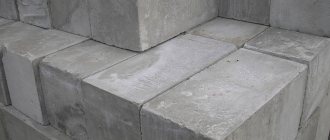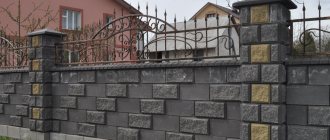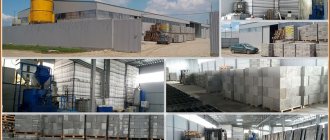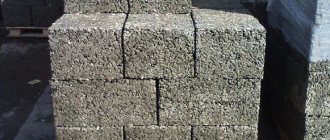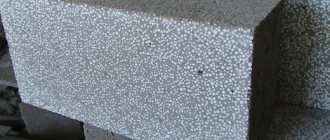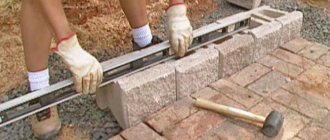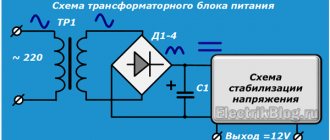- 1 Advantages and disadvantages
- 2 The process of laying blocks
- 3 Selection of adhesive composition
- 4 Recommendations for work
- 5 Conclusion
Modern materials for construction make it possible to shorten the duration of the construction process and reduce financial investments. At the same time, the quality of the structure does not suffer at all. Polystyrene concrete is such a material for high-quality house construction. This is a new exceptional material in the form of blocks, used in the construction of permanent structures of walls and partitions, used for insulating ceilings, attics and roofs. It is durable, easy to process, has excellent heat and sound insulation characteristics, is not flammable, is economical and environmentally friendly.
Advantages and disadvantages
Wall polystyrene concrete blocks have a number of advantages:
- The use of polystyrene concrete provides the room with natural warmth. Thanks to this property, there is no need for additional insulation, no heating equipment is required, which significantly reduces the cost of purchasing materials for thermal insulation, equipment, and reduces energy costs.
- Another advantage of the polystyrene concrete block is its plasticity, which eliminates the possibility of the formation of random cracks.
- Lightweight concrete blocks with the addition of Portland cement come in a variety of shapes, making their installation, drilling, driving in nails and screwing in self-tapping screws easier.
- The lightness of the block simplifies working with a polystyrene concrete wall and does not require auxiliary equipment.
- Possibility to install blocks yourself.
- Walls made of lightweight concrete with Portland cement have high sound insulation and vibration absorption.
- Light load on the foundation.
- Due to the large size of the blocks, laying them will not be difficult; moreover, the laying is simplified and accelerated.
- Low material cost.
When working with polystyrene concrete blocks, the following material disadvantages are observed:
- Low strength of installation of fastening elements to a polystyrene concrete wall. Self-tapping screws can be easily removed without tools. To increase the strength of the installation of fasteners, fastening is carried out according to certain rules.
- The low density of the material does not allow installing doors and windows into a wall made of polystyrene concrete blocks.
- Lightweight concrete mixed with Portland cement requires large shrinkage of the building.
- A wall made of polystyrene concrete needs to be plastered with a layer of at least two centimeters, which affects the total cost of the structure. Also, due to poor adhesion of the material, additional work is required before applying plaster.
- The blocks are not fire-resistant and are susceptible to high temperatures, which leads to a deterioration in thermal insulation properties.
- Low vapor permeability worsens the indoor microclimate and does not provide the house with optimal humidity.
Return to contents
Nuances of technology
The manufacturing technology of polystyrene concrete is based on mixing two main components: cement and polystyrene. But these materials, when mixed, and even more so when the solution placed in the molds for the production of blocks is vibrated, begin to separate. Polymer granules simply float to the surface of the concrete mass, which leads to a deterioration in its technical characteristics.
Increasing the amount of added water (to increase the adhesion of the granules) did not lead to anything. The solution lost its strength characteristics, its blocks cracked severely due to large shrinkage.
Therefore, the developers of the solution have been looking for additives for a long time that could hold the granules inside the cement paste. The most effective were substances that included air-entraining components. It turned out that air bubbles up to 0.3 mm in size filled the volume of the mixture, increasing it and reducing the differences in density between the cement mortar and polystyrene granules. That is why the material became plastic.
Today, protein foaming additives are most often used in the production technology of polystyrene blocks. Because they create a stable foam, which is characterized by high mobility and adhesion to any materials. Both characteristics increase the workability of polystyrene concrete. And this is regardless of the ratio of water and cement in the solution.
But even these additives cannot counteract the shrinkage of the solution. To reduce this process, it is necessary to keep the filler moist. This is the first option to avoid cracks in the blocks. The second is to use strong fibers as a reinforcing frame inside the concrete. The latter take on the stresses inside the dough associated with shrinkage processes. At the same time, the fibers increase bending and tensile strength.
As for the equipment for the production of polystyrene concrete, a mixing plant is installed in the technological chain. It is in this that all the ingredients of the solution are mixed together.
Block laying process
This technology for creating buildings is called the permanent formwork system.
Before laying the first row, you should prepare the work surface. To do this, the base is leveled and filled with concrete mixture with the addition of fine sand. After laying the cement composition, check the evenness of the surface using a building level. Prepare an adhesive solution that resembles thick sour cream. The glue is laid with a trowel of a width corresponding to the width of the masonry. After applying the adhesive, it is leveled. The resulting dust is immediately removed. When working with polystyrene concrete walls, it is important to pay special attention to the first row, since the further strength of the structure depends on it. Having completed laying the first layer, install beacons in the corners of the walls and connect them with fishing line or other similar object. Next, we lay out the wall blocks along the stretched line. The blocks must be laid with constant alignment according to the beacons.
Return to contents
Conclusion
If you chose foam blocks to build a house, it is important not to make a mistake when choosing glue, because this is the key to a successful and durable construction. Adhesive for blocks has positive characteristics: strength, durability, quick hardening and ease of preparing a solution
Moreover, its consumption is several times less than cement, which will help save on construction.
When choosing an adhesive mixture for foam concrete, pay attention to the composition, the manufacturer, and do not forget to read the instructions for preparing the solution, which will help you obtain the correct consistency and layer thickness
Selection of adhesive composition
In order for wall structures made of polystyrene concrete to last for decades, it is important to choose the right adhesive composition. Masonry can be carried out using a solution of cement and sand. This allows you to reduce the cost of materials, but whether there will be any benefit from this in the future, whether the original strength of the building will be preserved is a question. Using glue, at first glance, seems like an expensive pleasure, but it is worth considering the consumption per unit area, which is several times less than the consumption of concrete mixture. Thus, the savings are not justified. Moreover, the use of an adhesive ensures a tight fit of the materials, leaving only minor gaps.
The minimum thickness of the seams increases the thermal insulation properties of polystyrene concrete, creating a warm microclimate in the room.
The use of a mortar based on concrete and fine sand means thick inter-joint voids, which leads to high thermal conductivity of the walls. Because of this, condensation, mold, and mildew form, and indoor humidity and dampness increase. When laying polystyrene concrete elements on a cement-sand mortar, we risk getting unevenness and a decrease in strength during deformation. Experienced builders advise using special glue for laying walls made of polystyrene concrete, because only it can reduce the thickness of the seams and avoid the formation of cold bridges.
Return to contents
Our company produces its products in accordance with TU5741-002-00729014-2014
The main physical and mechanical characteristics of the materials are given in Table 1.
Table 1
Block brand Nominal volumetric weight, kg/m3 Average compressive strength, kgf/cm2 (MPa) Strength grade (strength class) Thermal conductivity coefficient (dry), W/m 0С Frost resistance, cycles Shrinkage deformation during drying at a holiday humidity of 15% and less, mm/me more Area of application of the material D2002002.5 (0.25) M20.069 F751.0 Thermal insulating polystyrene concrete is used for filling air channels (in liquid form), in brickwork, roofing and attic floors, thermal insulation of external walls made of brick or monolithic heavy and lightweight structural concrete, coatings, insulation of attic floors and other enclosing and load-bearing structures of buildings and structures. D3003004-5 (0.5) M5 (B0.35) 0.088 F1501.0 Thermal insulation and structural polystyrene concrete is used for thermal insulation of non-load-bearing and self-supporting walls, designed for long-term operation (at least 50 years), taking into account possible moistening and freezing - thawing when the temperature and humidity of the environment changes; for filling the enclosing structures of external walls and partitions of low-rise, mid-rise and multi-storey buildings not participating in the load-bearing frame of the building. D40040013-15 (1.5) M15 (B1) 0.11 F1501.0 Structural thermal insulating polystyrene concrete is used for masonry (from piece blocks) or pouring into formwork, including permanent external self-supporting and load-bearing walls of low-rise buildings; for filling the enclosing structures of external walls and partitions of mid-rise and multi-storey buildings not participating in the load-bearing frame of the building. 0.147F2000.9
Attention!!! Our region belongs to an area with seismic activity up to 9 points, therefore, when designing buildings and structures, designers take into account the requirements of regulatory documents, in particular SP 14-13330-2014 “Construction in seismic areas”. We draw your attention to this that the final decision when choosing a block brand for the construction of various elements of buildings and structures should be made by qualified specialists from construction and (or) design organizations.
PrintE-mail
Some builders lay polystyrene concrete blocks in cement-sand mortar. The basis of most of these considerations is definitely the goal of economy, which is not insignificant in construction.
An experienced builder and a person who is simply capable of thinking will always analyze his actions and calculate the benefits. Based on this principle, we will see that the cost of glue is 2 times higher than the cost of the mortar, but the consumption of glue per unit area is 6 times less than the consumption of cement-sand mortar. Therefore, the illusion of savings created by the low price of cement-sand mortar does not justify itself.
The use of special glue for laying polystyrene concrete blocks will ensure better adhesion of the material, thereby increasing thermal insulation.
The use of an adhesive solution ensures a tight fit of the individual particles, creating a minimum thickness of the seams between the blocks. In this way, high-quality thermal insulation is achieved.
When using concrete-sand mortar, the thickness of the seams increases, and gaps (cold bridges) form in the wall material. As a result, heat loss increases, condensation, dampness and mold appear. Also, a significant disadvantage of traditional concrete-sand mortars is the increase in unevenness of the masonry and a decrease in its flexural and compressive strength.
Most manufacturers of polystyrene concrete blocks recommend not to violate construction technology and advise using special glue for laying walls in order to reduce the gap between blocks and avoid the appearance of cold bridges.
Recommendations for work
When laying walls made of polystyrene concrete, it is important to follow the following recommendations:
- When building walls, it is important to adhere to the evenness of the blocks.
- Installation of blocks must be carried out in strict accordance with technological processes. It is worth remembering that once the glue has set, it will be impossible to dismantle the walls.
- According to the misconceptions of inexperienced builders, walls are laid using cement mortar with the addition of fine sand, however, such a choice of mixture is not justified and is not at all economical. Although the finished adhesive composition has a high cost, its consumption is six times less.
- Due to the use of glue when laying the walls, a small gap is formed, which does not allow the passage of cold into the room. Thus, the thermal insulation of polystyrene concrete structures is maintained.
- When constructing polystyrene concrete walls, it is worth considering possible pressures on the structure, which lead to the formation of cracks. They are formed as a result of temperature fluctuations, non-compliance with the principle of uniformity during building shrinkage, or due to soil subsidence. These cracks will not lead to the collapse of the structure, but will have a negative impact on the appearance of the structure.
- To protect polystyrene concrete walls from bending loads, reinforcement is used, which prevents cracks on the walls and their destruction.
- Drawing up a competent design and following production technology when laying walls will help to avoid the formation of cracks.
- Cracks can be eliminated by separating the wall laying using expansion joints and, in some cases, reinforcement. The reinforcement is installed in special reinforcing belts, and a small-diameter reinforcement structure is mounted between the blocks. Reinforcement is carried out every four rows, starting with the first one laid on the foundation. All areas with high loads should be reinforced. The reinforcement is laid in grooves, which are pre-cleaned and filled with glue. Next, the reinforcement is placed in glue and fixed. Any remaining adhesive should be removed immediately.
Return to contents
